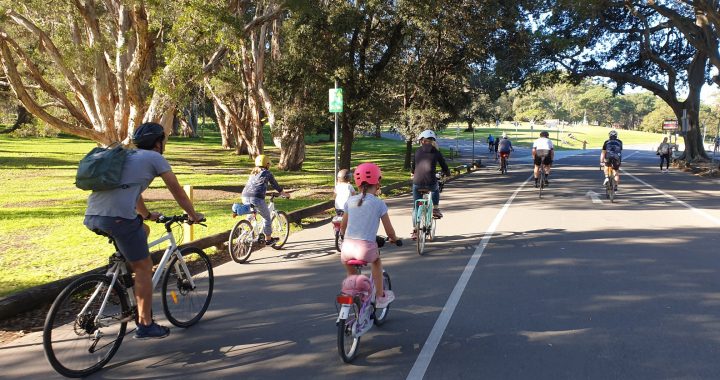In the face of the COVID-19 pandemic, it is essential to public health for state and local governments to provide space for people to adhere to social distancing requirements while undertaking essential travel or exercising. Urgent changes to public spaces are necessary to enable safe mobility and physical activity.
To support the public health goal of hindering the spread of COVID-19, it is essential to encourage cycling and walking. Everyone who cycles or walks instead of using public transport helps avoid the risk of infection or infecting others on buses, trains, or light rail. For those who do not have other options, public transport should be run to maximise their safety and convenience.
Maintaining the physical and mental health of the community is essential during the current health crisis. The World Health Organization recommends at least 60 minutes a day of medium to high intensity physical activity for children and adolescents, and at least 150 minutes (at moderate physical intensity) or 75 minutes (at high physical intensity) of physical activity per week for adults. Cycling and walking are accessible forms of exercise that have benefits for mental as well as physical health.
To safely accommodate the recently increasing numbers of people walking and cycling, including those making deliveries, and the sharp decrease in motor traffic, swift infrastructure adjustments are essential, such as temporary bicycle lanes and shared street space or local street closures where footpaths for pedestrians are crowded. With decreased motor traffic, motor vehicle speeds have increased, posing a greater danger to the increasing amount of non-motorized road users. Speed limits should be enforced and selectively reduced to lessen the risk of traffic accidents.
A number of cities such as Berlin and Bogotá have recently introduced tactical urbanism to convert road space so that people on bicycles and on foot have safer space to operate. Tactical urbanism can involve many forms of interim improvements to public space, including creating or widening footpaths and bike lanes using brightly painted concrete blocks and planters. The important aims here are to keep key workers and delivery people moving during shutdown and to allow safe social distancing for people to exercise.
BIKEast calls on the NSW Government to:
- Urgently rearrange road space to create additional temporary cycling and walking infrastructure and unlock additional public space for safe exercise, active transport and cycle deliveries. This could involve providing critical missing links in high-use Sydney cycling routes.
- Fund and facilitate local councils to take the same measures in relation to land and roads under their control, including by publishing evidence-based guidelines for the urgent implementation of temporary infrastructure.
- Streamline and simplify the application process for emergency infrastructure interventions, by creating a centralized “permission slip” system for local councils,
- Keep parks and other greenspace open while managing social distancing requirements.
Related articles & documents:
- New Zealand First Country To Fund Pop-Up Bike Lanes, Widened Sidewalks During Lockdown (Forbes, 13 Apr 2020)
- NZ Transport Agency – Innovating Streets for People pilot fund
- Smart Growth America – Complete Streets + COVID-19
- National Association of City Transportation Officials (NACTO) – COVID-19: Transportation Response Center
- More links – Creating safer spaces for cycling and walking during the Covid-19 pandemic – LINKS
